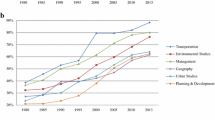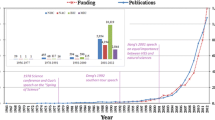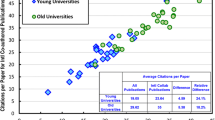Abstract
This paper examines patterns of Chinese authorship, focusing particularly on international co-authorship, in a sample of 37,526 articles from Elsevier journals published in 2004. Trends relating to potential influences such as subject, journal impact factor and article type are explored. A slightly higher proportion of articles with at least one Chinese author was observed as compared to previous studies. Articles that are a product of Chinese international collaboration account for almost 20% of the Chinese sample as a whole, a similar proportion to levels of international collaboration within the sample overall. Chinese international co-authorship is most common in the Earth & Environmental Sciences. Where China is involved in international collaboration, it is often a proactive participant: 49% of articles that are a result of Chinese international collaboration have a Chinese corresponding author. With some minor variations in subject categories, countries favoured in international co-authorship reflect world shares in publishing and factors such as geographical proximity and political links.
Similar content being viewed by others
References
Amin, M., Mabe, M. (2000), Impact Factors: use and abuse, Perspectives in Publishing, 1: 1–6.
Arunachalam, S., Doss, M. J. (2000), Mapping international collaboration in science in Asia through coauthorship analysis, Current Science, 79: 621–628.
Bassecoulard, E., Okubo, Y., Zitt, M. (2001), Insights in determinents of international scientific collaboration. In: Havemann, F., Wagner-Döbler, R., Kretschmer, H. (Eds), Collaboration in Science and Technology: Proceedings of the Second Berlin Workshop on Scientometrics and Infometrics, September 1st–3rd, 2000. Gesellschaft für Wissenschaftsforschung, Berlin, pp. 13–28.
Bennett, D. M., Taylor, D. M. (2003), Unethical practices in authorship of scientific papers, Emergency Medicine, 15: 263–270.
Bordons, M., Gómez, I., Fernández, M. T., Zulueta, M. A., Méndez, A. (1996), Local, domestic and international scientific collaboration in biomedical research, Scientometrics, 37: 279–295.
Braun, T., Glänzel, W., Schubert, A. (1999), A global snapshot of scientific trends, UNESCO Courier, 52: 28–29.
Braun, T., Glänzel, W., Schubert, A. (2000), How balanced is the Science Citation Index’s journal coverage? A preliminary overview of macrolevel statistical data. In: Cronin, B., Barsky Atkins, H. (Eds), The Web of Knowledge: A Festschrift in Honor of Eugene Garfield. American Society for Information Science, Medford, New Jersey, pp. 251–277.
Buela-Casal, G. (2004), Assessing the quality of articles and scientific journals: Proposal for weighted impact factor and a quality index, Psychology in Spain, 8: 60–76.
Carayannis, E. G., Laget, P. (2004), Transatlantic innovation infrastructure networks: Public-private, EU-US R&D partnerships, R & D Management, 34: 17–31.
Chen, L., Su, J., Mao, X. (2004), Funding pattern and policy research on National Science Foundation of China, Studies in Science of Science, 22: 581–588. (in Chinese).
Cronin, B. (1995), The Scholar’s Courtesy: The Role of Acknowledgements in the Primary Communication Process, Taylor and Francis, London.
Cronin, B. (2001), Hyperauthorship: A postmodern perversion or evidence of a structural shift in scholarly communication practices? Journal of the American Society for Information Science and Technology, 52: 558–569.
Cronin, B. (2004), Bowling alone together: Academic writing as distributed cognition, Journal of the American Society for Information Science and Technology, 55: 557–560.
Engels, A., Ruschenburg, T., Weingart, P. (2005), Recent internationalization of global environmental change research in Germany and the US, Scientometrics, 62: 67–85.
Flanagin, A., Carey, L., Fontanarosa, P. B., Phillips, S. G., Pace, B. P., Lundberg, G. D., Rennie, D. (1998), Prevalence of articles with honorary authors and ghost authors in peer-reviewed medical journals, The Journal of the American Medical Association, 280: 222–224.
Garfield, E. (1996), How can impact factors be improved? British Medical Journal, 313: 411–413.
Georghiou, L. (1998), Global cooperation in research, Research Policy, 27: 611–626.
Giles, C. L., Councill, I. G. (2004), Who gets acknowledged: Measuring scientific contributions through automatic acknowledgment indexing, Proceedings of the National Academy of Sciences of the United States of America, 101: 17599–17604.
Glänzel, W. (2001), National characteristics in international science co-authorship, Scientometrics, 51: 69–115.
Glänzel, W., Moed, H. F. (2002), Journal impact measures in bibliometric research, Scientometrics, 53: 171–193.
Glänzel, W., Schubert, A. (2001), Double effort = double impact? A critical view at international coauthorship in Chemistry, Scientometrics, 50: 199–214.
Goldfinch, S., Dale, T., Derouen, K. (2003), Science from the periphery: Collaboration, networks and ‘periphery effects’ in the citation of New Zealand Crown Research Institutes articles, 1995–2000, Scientometrics, 57: 321–337.
Gordon, M. D. (1980), A Critical reassessment of inferred relations between multiple authorship, scientific collaboration, the production of papers and their acceptance for publication, Scientometrics, 2: 193–201.
He, T., Zhang, J., Teng, L. (2005), Basic research in biochemistry and molecular biology in China: A bibliometric analysis, Scientometrics, 62: 249–259.
Jin, B., Rousseau, R. (2004), Evaluation of research performance and scientometric indicators in China. In: Moed, H. F., Glänzel, W., Schmoch, U. (Eds), Handbook of Qualitative Science and Technology Research. Kluwer Academic Publishers, Dordrecht and London, pp. 497–514.
Katz, J. S., Martin, B. R. (1997), What is research collaboration? Research Policy, 26: 1–18.
King, D. A. (2004), The scientific impact of nations, Nature, 430: 311–316.
King, J. T. (2000), How many neurosurgeons does it take to write a research article? Authorship proliferation in neurological research, Neurosurgery, 47: 435–440.
Laband, D. N., Tollison, R. D. (2000), Intellectual collaboration, Journal of Political Economy, 108: 632–662.
Laudel, G. (2002), What do we measure by co-authorships? Research Evaluation, 11: 3–15.
Leimu, R., Koricheva, J. (2005), Does scientific collaboration increase the impact of ecological articles? Bioscience, 55: 438–443.
Leydesdorff, L., Zhou, P. (2005), Are the contributions of China and Korea upsetting the world system of science? Scientometrics, 63: 617–630.
Ma, N., Guan, J. (2005), An exploratory study on collaboration profiles of Chinese publications in molecular biology, Scientometrics, 65: 343–355.
Matthiessen, C. W., Schwarz, A. W., Find, S. (2002), The top-level global research system, 1997–99: Centres, networks and nodality. An analysis based on bibliometric indicators, Urban Studies, 39: 903–927.
Meadows, J. (2000), The growth of journal literature: A historical perspective. In: Cronin, B., Barsky Atkins, H. (Eds), The Web of Knowledge: A Festschrift in Honor of Eugene Garfield. American Society for Information Science, Medford, New Jersey, pp. 87–107.
Merton, R. K., Garfield, E. (1986), Foreword. In: Price, D. J. de Solla (Ed.), Little Science, Big Science… and Beyond. Columbia University Press, New York, NY. [Available at: http://www.garfield.library.upenn.edu/essays/v10p072y1987.pdf]
Meyer, M., Bhattacharya, S. (2004), Commonalities and differences between scholarly and technical collaboration — an exploration of co-invention and co-authorship analyses, Scientometrics, 61: 443–456.
Nagpaul, P. S. (2003), Exploring a pseudo-regression model of transnational cooperation in science, Scientometrics, 56: 403–416.
Pavitt, K. (1998), The social shaping of the national science base, Research Policy, 27: 793–805.
Porac, J. F., Wade, J. B., Fischer, H. M., Brown, J., Kanfer, A., Bowker, G. (2004), Human capital heterogeneity, collaborative relationships, and publication patterns in a multidisciplinary scientific alliance: A comparative case study of two scientific teams, Research Policy, 33: 661–678.
Price, D. J. de Solla (1963), Little Science, Big Science, Columbia University Press, New York.
Rennie, D., Flanagin, A. (1994), Authorship! Authorship!: guests, ghosts, grafters and the two-sided coin (editorial), The Journal of the American Medical Association, 271: 469–471.
Russell, J. M. (2001), Scientific communication at the beginning of the twenty-first century, International Social Science Journal, 168: 271–282.
Schummer, J. (2004), Multidisciplinarity, interdisciplinarity, and patterns of research collaboration in nanoscience and nanotechnology, Scientometrics, 59: 425–465.
Seglen, P. O. (1997), Why the impact factor of journals should not be used for evaluating research, British Medical Journal, 314: 498–502.
Shapiro, D. W., Wenger, N. S., Shapiro, M. (1994), The contributions of authors to multi-authored biomedical research papers, The Journal of the American Medical Association, 271: 438–442.
The Publishers Association (2005), The Attitudes of Chinese Academics to Foreign Scholarly Journals: part 1, report, The Publishers Association, London.
Van Raan, A. F. J. (1998), The influence of international collaboration on the impact of research results, Scientometrics, 42: 423–428.
Verbeek, A., Debackere, K., Luwel, M., Zimmermann, E. (2002), Measuring progress and evolution in science and technology — I: The multiple uses of bibliometric indicators, International Journal of Management Reviews, 4: 179–211.
Wagner, C. S. (2005), Six case studies of international collaboration in science, Scientometrics, 62: 3–26.
Wagner, C. S., Leydesdorff, L. (2005), Network structure, self organisation and the growth of international collaboration in science, Research Policy, 34: 1606–1618.
Wang, Y., Wu, Y. (2001), Status and trend of scientific and technical collaboration between People’s Republic of China and Commonwealth of Australia. In: Havemann, F., Wagner-Döbler, R., Kretschmer, H. (Eds), Collaboration in Science and Technology: Proceedings of the Second Berlin Workshop on Scientometrics and Infometrics, September 1st–3rd, 2000. Gesellschaft für Wissenschaftsforschung, Berlin, pp. 211–219.
Wang, Y., Wu, Y., Pan, Y., Ma, Z., Rousseau, R. (2005), Scientific collaboration in china as reflected in co-authorship, Scientometrics, 62: 183–198.
Zhang, H., Guo, H. (1997), Research collaboration in China, Scientometrics, 38: 309–319.
Zhou, P., Leydesdorff, L. (2006), The emergence of China as a leading nation in science, Research Policy, 85: 83–104.
Author information
Authors and Affiliations
Corresponding author
Additional information
In the context of this project, the term ‘Chinese authors’ is used to refer to authors, regardless of nationality, who are based at Chinese institutions. The term does not include Chinese nationality authors who are based in institutions outwith China.
Rights and permissions
About this article
Cite this article
Royle, J., Coles, L., Williams, D. et al. Publishing in international journals. Scientometrics 71, 59–86 (2007). https://doi.org/10.1007/s11192-007-1648-5
Received:
Issue Date:
DOI: https://doi.org/10.1007/s11192-007-1648-5




